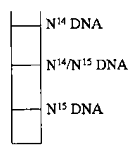 Multiple Choice Questions
Multiple Choice QuestionsDuring DNA replication, events at the replication fork different types of enzymes having specialized functions except
DNA Polymerase III
DNA gyrase
DNA ligase
DNA glycosylase
Which of the following names is appropriate for the sequence 5’-D/ANNAUG-3’ in a mammalian mRNA?
Shine-Dalgamo sequence
Kozak sequence
Internal ribosome entry sites
Translational termination site
The specificity of tRNA recognition by a aminoacyl tRNA synthetase that is intrinsic to the tRNA molecule lies on
Acceptor stem
Acceptor stem and anticodon loop
Anticodon loop
D-arm
The semi- conservative nature of DNA replication was established by Meselson and Stahl in their classic experiment with bacteria. They grew bacteria in N15 – NH4Cl containing medium, washed and then incubated in fresh medium with N14- containing compounds and allowed to grow for three generations. CsCl density gradient centrifugation of isolated DNA established the nature of semi-conservative DNA replication. The pictorial representation below shows the position of differentially labeled in CsCl density gradient.

Had the DNA replication been conservative, what would have been the pattern?
![]()
![]()
![]()
![]()
C.
![]()
If the DNA replication was conservative, then according to the pictorial representation given in the question, the pattern will be as option 3.
In E. coli, rec A gene is involved in recombination as well as repair and dna B gene is involved in unwinding of DNA double strands during replication. Which of the following statement is/ are correct abour rec A and DNA B?
A. Mutation in E.coli rec A gene is lethal.
B. E.coli with mutated DNA B gene does not survive.
C. DNA B after uncoiling DNA double strands, prevents further reannealing at the separated strands.
D. Rec A gene is involved in SOS response and helps DNA repair.
The correct options are:
B and C
A and B
B and D
A and C
The challenges faced by aminoacyl tRNA synthetases in selecting the correct amino acid is more daunting than its recognition of the appropriate tRNA. In case of amino acids with similar structures like valine and isoleucine, this challenge is met by the enzyme possibly through its
A. Catalytic pocket
B. Editing Pocket
C. Anticodon loop
D. Acceptor arm.
Choose the correct set from the following:
A and B
A and C
B and D
B and C
Optical density of a 400 base pair long 1 ml DNA solution was found to be 0.052. How many DNA molecules are present in the solution?
[1 base pair = 650 dalton, optical density of 1.0 D corresponds to 50 µg DNA/ ml]
6.023 x 1012
6.023 x 1018
4.633 x 1018
5.2 x 1013
The oligopeptide, F-A-R-P-M-T-S-R-P-G-F, is treated with trypsin, chymotrypsin, and carboxypeptidase-B. Apart from the original peptide, the number of fragments obtained will be:
4
3
2
0
Which one of the following interaction plays a major role in stabilizing B-DNA?
Hydrogen bond
Hydrophobic interaction
Van der Waal’s interaction
Ionic interactions
Site-specific recombination results in precise DNA rearrangements, which is limited to specific sequences. The enzymes that are important out the process are
Restriction endonuclease and DNA polymerase
Nuclease and ligase
DNA polymerase and ligase
DNA polymerase and DNA gyrase.
